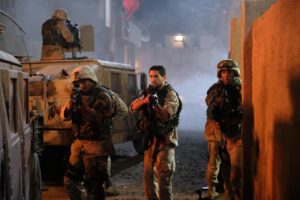

Darius Homayoun portrays Jassim Al-Lani (C) and cast on the set. (Photo: National Geographic/Van Redin)
From executive producer, Mike Medavoy (The Thin Red Line, Black Swan, Zodiac) comes this gripping 8-episode global event television miniseries revolving around the battle in Sadr City, Iraq, which focuses on the real-life perspectives of American soldiers with side by side in-depth family experiences during the Iraq War. The series is based on the acclaimed New York Times best-selling book, The Long Road Home: A Story of War and Family, written by Martha Raddatz. The series, The Long Road Home was created by showrunner, Mikko Alanne (The 33, 5 Days of War) and is one of National Geographic’s riveting scripted programs.
Documentary filmmaker, Mikko Alanne, instantaneously became passionate about the book as it was unlike any other war story about soldiers in combat, simultaneously representing an intimate view of their families, along with the soldiers’ reality, deep inside the uniform. Initially, the concept was developed into a 3-hour feature film, yet even with the extended run time, there was still no plausible method to include the entire story. As the project expanded into a miniseries, it allowed for a more thorough look into each character, rather than just focusing on the aftermath of war.
Adapting a book of this magnitude is no easy task, especially mirroring real life events and people. Alanne explained, “I started first by spending a week with Martha in Washington where we laid out who we thought we should focus the story on, watched her raw footage of all the interviews she had done, and then we traveled the country meeting different people. By the end of it, I spoke to close to 70 soldiers and family members, specifically 12-15 people became very close on the project on different aspects. The soldiers and the families would be our guide and our teachers in telling this story right.”

The showrunner spent a year and a half creating the three-hour version of the story. The series bible laid out each of the episodes in terms of the central character, beat by beat, cliff hangers, and the two writing periods. The story had to be broken up ahead of time to delve into the outlines and the script. All the scripts had to be detailed to ensure each character arc spanned throughout all 8 episodes. The home scenes were filmed first, before the war.
Some of the challenges that exist when adapting a true story are the immense cast of characters portrayed in the book. There were 60 people who were followed intimately in the book, so the process had to be narrowed to specific points of view that will give the audience a full grasp of everyone, from the high-ranking officers to the Privates. Showing diversity of experiences was key.
Other obstacles would be portraying the Middle East realistically. The thought of filming in Morocco or Jordan was intriguing, but it was not feasible to accomplish everything with the restrictions in those areas. The idea was born to recreate the city inside Fort Hood, thus giving complete control over the shooting schedule. Building a city is obviously a major undertaking, as the crew took over the base for several months. The Production Designer and Art Director had researched, designed, and built the sets which became the largest sets in North America at the time, spanning twelve acres with 80 buildings. In the show, there are two buildings that have a geographical marker, which are exact replicates of the buildings in Traverse City. The replications were only conceivable through photographs taken from the real-life soldiers during their time in Iraq.

Alanne concluded, “Only one percent of our nation currently serves in Armed Forces. I hope the series can really illuminate what it’s like to say goodbye to your spouse who’s going to go away for a year, knowing they will be in mortal danger the whole time. Also, what the wives go through on the home front. I wanted the series to show what it’s really like to go to war and the cost of it as a consequence. I hope people will feel that this is the most intimate portrait of the American soldier of the American military family than anyone has ever done for TV.”





